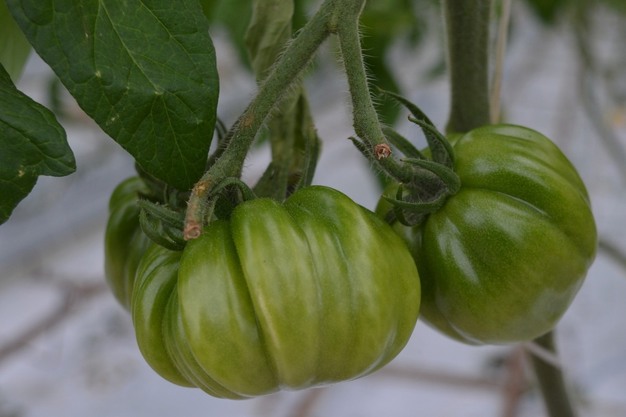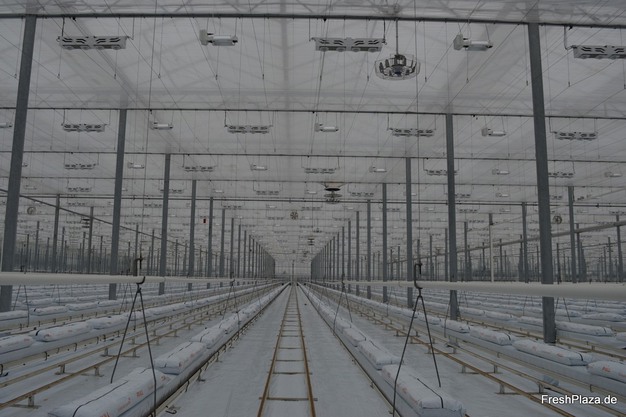The modern horticultural business Höfler Gemüse GbR. in the heart of the Knoblauchland region harvests mini cucumbers all year round, in the low-light phases until well into March from lighted cultivation. "Since 2021, we have had lighting systems for our mini cucumbers (1.7 ha). Although the demand for mini cucumbers is lower in winter, it is quite constant. However, the increased energy costs have a significant impact here. As long as we have good yields and prices, we can absorb these additional costs to a certain extent, although we did not manage to do so last year (2024). Admittedly, I wouldn't make the same investment again in retrospect. Back when we invested in the lighting systems, gas prices were still relatively low, which is why the calculation was of course incomparable to the current situation," explains Simon Höfler, who manages the company together with his two brothers.
Click here for the complete photo report of our producer tour.

Höfler's tomato range includes seven varieties, including oxheart tomatoes, as well as vine tomatoes, plum tomatoes, cherry vine tomatoes, grape vine tomatoes, cocktail and plum cocktail tomatoes. Tomatoes are harvested starting in mid-March, while the new harvest campaign for bell peppers starts gradually in early to mid-April.
Lack of HR varieties in tomato cultivation
"We have the advantage of being on the market relatively early with tomatoes and bell peppers. Compared to most of our colleagues, we plant about six weeks earlier and then ultimately get to market about three to four weeks earlier. In this respect, we have a certain competitive advantage over food retailers," Höfler continues.
The regional outbreak of the tomato virus (Tobrfv), dreaded in commercial horticulture, also caused the Höfler company great concern. "Fortunately, we have been spared by the Jordan virus so far. We have considered equipping our plants with new, resistant varieties. However, the problem is that there is still no reasonable alternative for oxheart tomatoes, which are among our most important tomato crops in terms of quantity. We are also continuing to rely on the proven varieties of cherry and grape tomatoes due to a lack of alternatives. For vine tomatoes, we have already converted to HR varieties for the 2024 season, but yields are significantly lower than those of the tried and tested varieties," the tomato grower sums up.
 Simon Höfler cultivates around 8 ha of greenhouse vegetables (including 4.7 ha of cucumbers, 2.3 ha of tomatoes, and almost 1 ha of peppers) and markets his produce both through the nearby Franken-Gemüse eG and independently to food retailers and via the Bavarian wholesale markets. He also grows lemongrass on a small scale.
Simon Höfler cultivates around 8 ha of greenhouse vegetables (including 4.7 ha of cucumbers, 2.3 ha of tomatoes, and almost 1 ha of peppers) and markets his produce both through the nearby Franken-Gemüse eG and independently to food retailers and via the Bavarian wholesale markets. He also grows lemongrass on a small scale.
Declining ginger cultivation
In addition to the greenhouse cultivation of fruit vegetables and lamb's lettuce, the Höfler family has also been dedicating itself to the production of fresh ginger for the past five years. Höfler: "After we discovered the marketing potential for regional ginger at the wholesale market, production was increased relatively quickly. However, it turned out that crop rotation is quite challenging, i.e., if the same area is planted several times, the yield decreases noticeably. Unfortunately, of the original food retail customers who listed our products, only one remains, and they have significantly reduced their tonnage."
This has already led to the fact that at the end of last year, goods had to be disposed of. "Accordingly, we have decided to reduce our cultivation capacities this year from around 0.7 to about half." The required ginger seedlings will be propagated by the company itself and planted from calendar week 13. The harvest window extends from the end of July to the beginning of December. The marketing is done both loose via the wholesale market and packaged in 250-300g units in food retail stores.

Insight into the lighted greenhouse: in mid-February, the plant was equipped with new mini-cucumber plants. From an operational perspective, the lighted tomato cultivation would not be an option for the company at this time.
For more information:
Simon Höfler
Höfler Gemüse GbR
Spargelfeldweg 1
90425 Nuremberg
Tel: +49 0911 3770641
info@hoeflergemuese.de
www.hoeflergemuese.de
